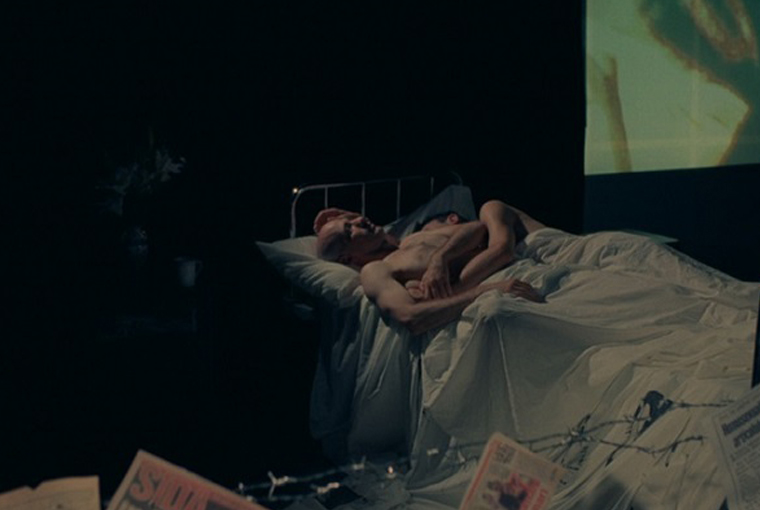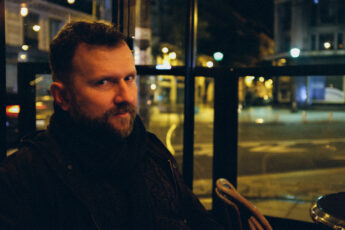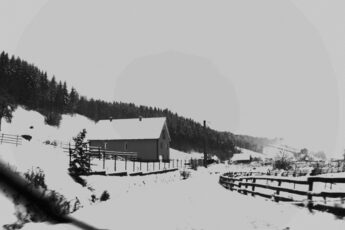From Private to Public
Bogdan Balla’s I Had Been Sleepwalking When I Saw All Those Colors (2021)
Vol. 128 (October 2022) by Anna Doyle
One of the most captivating works showcased at the 2021 BIEFF (Bucharest Experimental Film Festival) was a graduation film. The experimental work by young filmmaker Bogdan Balla entitled “I Had Been Sleepwalking When I Saw All Those Colors” portrays two queer lovers in their sleep as they lay together and sleepwalk around the space around them. Throughout the film, they are enclosed by barbed wire, and the bed is set in front of a filmic installation. In the background, images produced by Bogdan Balla and English experimental filmmaker Derek Jarman are intercut on a big screen. In their sleepwalking state, the lovers in Balla’s film share an intimate and sensorial experience that reflects their unison. Displayed as sculptures would be in an exhibition space, their intimacy is both playful yet overshadowed by the grim history of LGBTQ+ rights in Romania.
Balla’s film is a homage to Derek Jarman, the filmmaker and activist who died of AIDS in 1994 and who produced some of the most radical films during the Thatcher period in the UK. In Balla’s film, intimate and bodily experiences are identified as political acts. The private sphere is explored so as to question the current reality of the public sphere, specifically in the context of contemporary Romania. Casting figures of the queer scene was essential for this film – the film features nonbinary activist and performance artist Paul Dunca/Paula Dunker, an important figure in the queer party movement in Bucharest and an actor/actress in many Romanian independent theater shows, alongside István Téglás, a fellow theater actor who came out this year and associated himself with the 2022 Bucharest Pride campaign. The installation in the background takes images from a Jarman installation conceived in response to the insidious Section 28 introduced under Thatcher’s government. The amendment to the Local Government Act 1988 banned the “promotion” of homosexuality by local authorities and schools. Inspired by Jarman’s cinema and militancy, Balla here contests the way that politics and mainstream media in Romania have stigmatized queer existence, as well as the way that everyday micropower relations have perpetuated the expulsion of queer life from the public. Balla also investigates how identity and bodily experience interact through affect.
Queer history in 20th century Romania is repressive even in comparison to other European countries. It is worth remembering that from 1957 to 1996, in Romania, both public and private acts “provoking scandal” were illegal. The details of the law were murky and certainly subject to arbitrariness. During Nicolae Ceaușescu’s rule (1965-1989), the already repressive legislature was tightened and specified through the passing of Article 200, whereby homosexuality was criminalized in both the public and the private domains. Consensual sexual relations between persons of the same sex could now be punished by a prison term between one and five years, and homosexuals were considered mentally ill. Experimental filmmakers of the Ceaușescu area began to address these injustices by producing radical films in their art studios. A notable example is experimental filmmaker Ion Grigorescu’s 1976 Masculine/Feminine, in which the artist is seen filming himself naked in his studio in front of a mirror. He adopts both masculine and female poses to illustrate the multiplicity of genders coexisting within each and every one of us (albeit from a binary viewpoint). According to Piotr Piotrowski, the artist also challenges the ways that male bodies are usually represented by turning the ‘male gaze’ on himself.1 The self-exploration is continuously intercut with images from the facades of Bucharest, which helps further contrast the intimate self-exploration (in Grigorescu’s studio) with the official policy of concealment, ignorance and suppression (out in the open). In the 1990s, gay rights activists and the European Council successfully pressured the Romanian government to change its penal code in relation to homosexuality. Only in January 2001 was Article 200 repealed though, with same-sex relationships finally being decriminalized. However, same-sex marriages and forming civil unions are still not legal in Romania. Meanwhile, homophobia is omnipresent in the public sphere. (Homophobic acts are often committed by supporters of the right-wing Greater Romania Party, which almost prevented the Bucharest’s 2007 annual GayFest pride parade from happening.)
Set in a room that is both an affective intimate interior and an atmospheric exhibition space, the film explores how political and emotional forces affect queer embodied experiences. In a dreamy atmosphere conjured through a blueish overtone, elective affinities between the lovers are performed both textually and visually, demonstrating the power of attraction between lovers. The two bodies are seen embracing in a bed, and then one after the other they slowly get up as if they were sleepwalking. In the European art tradition, the male body is often associated with action, while the female one is trapped in constellations of displaying itself and thus being exposed to voyeurism. However, here the male body is exposed outside a ‘scopic desire’ of a ‘gaze’ and is seen as non-active. At the end of the film, the bed remains empty while the sheets still show the traces of the now-absent bodies. A bed is perhaps the most intimate place there is, yet here it is revealed to us as a space of public display, which is further linked to the political sphere through the female voiceover.
The voiceover in the film tells the story of a homosexual couple who were verbally and physically abused by a homophobic man, who threatened to call the police and tell on them. The narration describes the image of the man pointing his fist at the gay couple embracing on a bus. This daily event is evoked in terms of affect. The attraction and disengagement between the two lovers on screen manifests the affective variations of bodily forces interacting in the film. Contemporary theory has interpreted Spinoza’s concept of ‘affectus’ as relating to interpersonal impulses and emotions – for Spinoza, affect either augments or diminishes the body’s power of activity according to the act of embracing or rejecting external stimuli. The capacity of the body is not confined to or determined by the body itself but is instead a web of relations. In Balla’s film, these affective relations are discussed throughout the voiceover, which relates that tolerance and intolerance are affective reactions: intolerance from the homophobic man is like an exterior-stimulus that represses and diminishes non-normative bodies to affirm themselves. This shows that the intimate experience of love and its affirmation is not unrelated to the exterior reactions of the public sphere and their negation of what is different.
The vulnerability of the couple pushes the main character to perform an act of virtual revenge against the homophobic man. In the voiceover, he becomes menacing, perhaps responding in his mind in a way he deems too dangerous in the real world: “My other eye is watchful. And when you think I’m half-asleep, a ray from an unseen world/Dwells on you in guilt and kills you.” Not being able to express anger out in the open, the character in the voiceover is left to this silent form of revenge as the couple are threatened with both verbal and physical violence. The film shows that suffering and distress do not stem from an abstract and intrinsic queer identity, but rather from everyday interactions in a heteronormative and often homophobic public sphere that forces queer subjects into silence and secrecy.
Aesthetic and radical, passive yet powerful, Bogdan Balla’s experimental short departs from Derek Jarman’s methods and early Romanian experimental filmmaking to show that Romanian contemporary society still has to deal with the same political challenges that artists of the 20th century had to deal with. As delicate and alluring as the image of bodies peacefully sleeping in front of images of a gay couple embracing in the Derek Jarman video may be, it is disturbed by the violence that is represented by the barbed wire that surrounds them. The entrapping barbed wire around the bed reminds us of the legalized harassment and imprisonment of homosexuals in Romania, and of their defiant resilience. Newspapers are attached to the barbed wire. Most of these newspapers have ‘gay bashing’ headlines, and they were released both before and after the decriminalization of homosexuality in 2001. In this suffocating atmosphere, which expresses the all-pervasive threat to LGBTQ+ love, the boundaries between the private and public spheres become blurred.
The film displayed in the background primarily consists of homoerotic images in opaque lighting. Jarman’s films often evoke a magical atmosphere in which queer lovers take a journey to explore their own desires. Jarman has described Angelic Conversations, another film he made, as “a dream world, a world of magic and ritual, yet there are images there of the burning cars and radar systems, which remind you there is a price to be paid in order to gain this dream in the face of a world of violence.”2 Bogdan Balla presents a naked youth whose radical sexuality is perceived as a provocation by modern societies, which fulfill their controlling fantasies by enforcing harsh biopolitics. The story of everyday aggression related in the voiceover, and the scenography with the barbed wire and the homophobic newspaper headlines, reflect the impossibility of truly separating out the private from the public sphere, and “the price” that individuals pay for trying to fulfill this dream for themselves. I Had Been Sleepwalking When I Saw All Those Colors is a moving short that powerfully stages the elective affinities and affective relations that exist between the private and public spheres. Yet, alerting the spectator to the dangers of these interactions, the film is set in a colorful blurry state of oblivion in which the languid mingles with the erotic and passivity turns into resistance.
References
- 1.Piotrowski, Piotr. `Male Artist’s Body: National Identity vs. Identity Politics.’ In: Laura Hoptman and Tomáš Pospíšil (Ed.). Primary Documents. A Sourcebook for Eastern and Central European Art since the 1950s. Cambrige: MIT Press, 2002. 225-233; 230.
- 2.Jarman, Derek. Kicking the pricks. Minneapolis: University of Minnesota Press, 1997. 133.




Leave a Comment